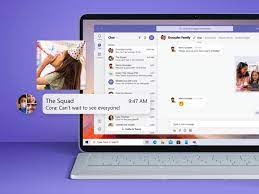If you’ve upgraded to Windows 11 you’ve probably noticed that Microsoft Teams is front and center on the new-look taskbar. Having long been primarily for business users, Microsoft is now pushing the chat app as a consumer option too, ready to replace Skype, Slack, Facebook Messenger, and any other communication tools you’re already using.
Here, you’ve got some options—you can set it to Available, Appear Away, and Appear Offline. Whatever you choose, this won’t affect your ability to send and receive messages. To go further, pick Set status message from the same drop-down menu. This lets you set a custom message for other people to see, so you can provide more detail on what you’re currently doing—try “on lunch” or “in a meeting.” Here, you can also set an expiration time for it, so it automatically disappears at the end of the day, at the end of the week, or after one or four hours.
Teams works well for sending quick bursts of text and emojis to your contacts, but you can compose more detailed messages if you want to. To do that, click on the Format button underneath the text entry box—the icon is an A next to a pen shape.
This opens up a whole host of extra options for you. You can change the size and color of the text, add indentations and bullets, drop in divider lines, and even include a table in your message. Hover the cursor over all of the icons on the toolbar to see what each one does.
As you start to use Microsoft Teams more and more, it can be difficult to keep up with all the individual conversations and group chats that you’re involved in. The main Chat panel has a filter option that can be helpful here.
Click Chat to get to all of your messages, then click the Filter button at the top of the conversation list (three horizontal lines). Choose Unread, and Teams will show you all of the messages you’ve not had a chance to look at yet.
Microsoft Teams isn’t for everyone, and you might not necessarily appreciate the way it’s been placed right in the middle of the taskbar in Windows 11. To remove the shortcut (and any other system shortcuts, like Search or Widgets), open the Start menu and choose Settings. There, click Personalization then Taskbar, and you can turn the Chat toggle switch off.
Teams will still be installed on your computer and available through the Start menu if you need it. To remove it completely, open Settings, then choose Apps and Apps & features. Click the three dots next to Microsoft Teams to find the Uninstall option.
Source : https://www.popsci.com/diy/microsoft-teams-tips/







